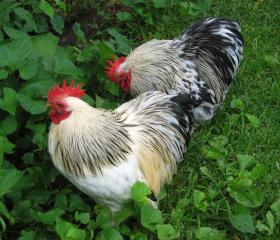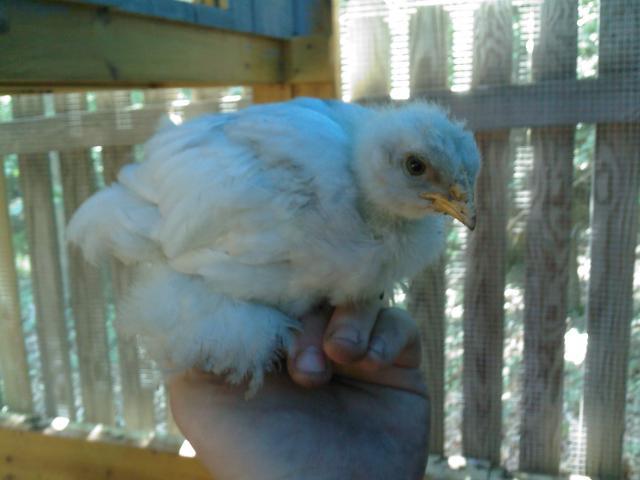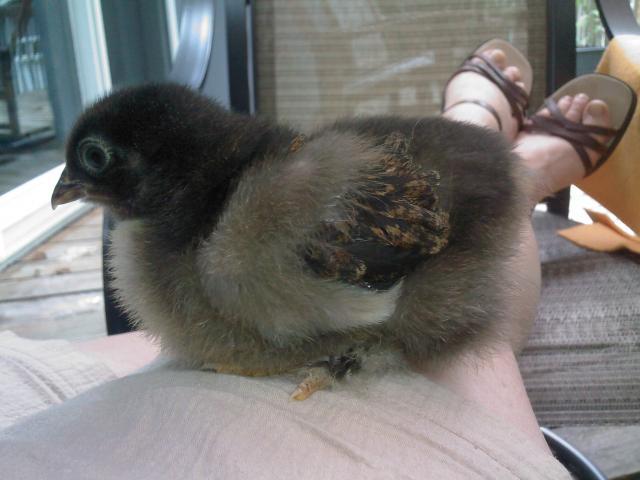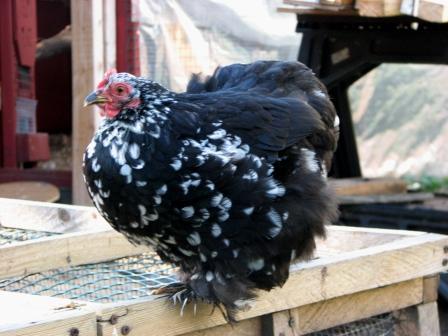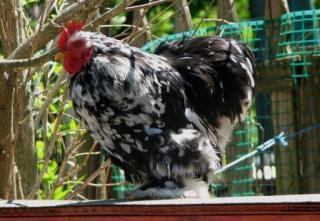abbey2140 wrote:
Does anyone know for sure how much black should be on a columbian cochin?
The drawings/paintings by Katherine Plummer are a good basis for the ideal looking Columbian from outside the cage. However, they don't show you the finer details that actually dictate how crisp you can get the hackle and saddle markings and tail covers in the males and females.
The main issue with just about every Columbian Cochin Bantam out there is their wing pattern or lack of it actually. It's a tricky task to get the wing color correct without overmarking the males and females. The hackles on both the males and the females should be black with a distinct crisp outline or lacing of white. The tops of the head should be white. Their capes should be Black laced/edged with white. The markings on the male saddles should be diamond shaped starting about halfway up from the base of the feather, but the marking shouldn't start immediately where the cape ends off. What I mean is there is supposed to be a band of clear white across the back of the males and the saddle markings should start until farther down the back toward the cushion. Most males in the Columbian Cochins carry the saddle markings too far into the backs and most don't have well defined saddle markings and you'll see white in the middle of the diamond shape. The main tail of both the males and the females are supposed to be black with the tail covers black, edged with white. Most of the Columbians you'lll find are poor in the tail covert area. They'll be black with splotches of white instead of laced with white. You'll also find females with black ticking in the back, even to the point of showing some pattern. Females should have clear white backs, and the undercolor should be slate/gray.
The wings (which you can't see in illustrations) are difficult to get correct, and the wing pattern (IMO) is directly related to how well the rest of the bird will be marked. I base this in my observations of my Columbian Wyandottes and Columbian Rocks. Both of which are much better marked than the Columbian Cochins. The secondaries are basically supposed to be half white and half black. You can get the word for word description out of the standard, but essentially the shaft of the feather is the point of separation for the Black and the white. The secondaries are the wing feathers that show when the bird is looked at from the side, and the outer half is the side that is white, with the black side underneath the feather next to it. The primaries are the disaster area. Ultimately you are looking for a basically black feather edged in white on the outerside (the side away from the body). I've yet to breed a Columbian Cochin with good wing color. I've had a couple that are decent, but nothing I would consider good specimens of how the wings should look. The SOP has illustrations of Columbian Feather patterns and includes the wing feathers.
The better you can get the wings (again IMO), the more crisp the markings in the rest of the bird. However, what I've noticed in the Cochins is that the better I get the wings (i.e., more solid black primaries), the more overmarked the males tend to be. We'll see how this year's youngsters shape up. I have some good top colored birds coming along, but the wings thus far don't appear to be setting the world on fire. You can't cull for it, because you'd wind up culling every bird, so you have to find an acceptable bird and keep striving to improve a little at a time. The type on my Columbians is as good as the Blacks and Whites, but they will never compete beyond their variety class until we can get better wing markings.
The other thing I'd point out is that they tend to be brassy. Not brassy because of the sun, but brassy genetically. Select away from this. In the males it sometimes doesn't show up until they are two year olds. I'd advise against breeding with a male that is naturally brassy, or shows creaminess in his wing bar/bay area. The Columbian Rocks and Wyandottes are distinctly white and black and the contrasting colors with the Columbian pattern are gorgeous and one of my favorite patterns. Very tough to get right in the Cochins.
Does anyone know for sure how much black should be on a columbian cochin?
The drawings/paintings by Katherine Plummer are a good basis for the ideal looking Columbian from outside the cage. However, they don't show you the finer details that actually dictate how crisp you can get the hackle and saddle markings and tail covers in the males and females.
The main issue with just about every Columbian Cochin Bantam out there is their wing pattern or lack of it actually. It's a tricky task to get the wing color correct without overmarking the males and females. The hackles on both the males and the females should be black with a distinct crisp outline or lacing of white. The tops of the head should be white. Their capes should be Black laced/edged with white. The markings on the male saddles should be diamond shaped starting about halfway up from the base of the feather, but the marking shouldn't start immediately where the cape ends off. What I mean is there is supposed to be a band of clear white across the back of the males and the saddle markings should start until farther down the back toward the cushion. Most males in the Columbian Cochins carry the saddle markings too far into the backs and most don't have well defined saddle markings and you'll see white in the middle of the diamond shape. The main tail of both the males and the females are supposed to be black with the tail covers black, edged with white. Most of the Columbians you'lll find are poor in the tail covert area. They'll be black with splotches of white instead of laced with white. You'll also find females with black ticking in the back, even to the point of showing some pattern. Females should have clear white backs, and the undercolor should be slate/gray.
The wings (which you can't see in illustrations) are difficult to get correct, and the wing pattern (IMO) is directly related to how well the rest of the bird will be marked. I base this in my observations of my Columbian Wyandottes and Columbian Rocks. Both of which are much better marked than the Columbian Cochins. The secondaries are basically supposed to be half white and half black. You can get the word for word description out of the standard, but essentially the shaft of the feather is the point of separation for the Black and the white. The secondaries are the wing feathers that show when the bird is looked at from the side, and the outer half is the side that is white, with the black side underneath the feather next to it. The primaries are the disaster area. Ultimately you are looking for a basically black feather edged in white on the outerside (the side away from the body). I've yet to breed a Columbian Cochin with good wing color. I've had a couple that are decent, but nothing I would consider good specimens of how the wings should look. The SOP has illustrations of Columbian Feather patterns and includes the wing feathers.
The better you can get the wings (again IMO), the more crisp the markings in the rest of the bird. However, what I've noticed in the Cochins is that the better I get the wings (i.e., more solid black primaries), the more overmarked the males tend to be. We'll see how this year's youngsters shape up. I have some good top colored birds coming along, but the wings thus far don't appear to be setting the world on fire. You can't cull for it, because you'd wind up culling every bird, so you have to find an acceptable bird and keep striving to improve a little at a time. The type on my Columbians is as good as the Blacks and Whites, but they will never compete beyond their variety class until we can get better wing markings.
The other thing I'd point out is that they tend to be brassy. Not brassy because of the sun, but brassy genetically. Select away from this. In the males it sometimes doesn't show up until they are two year olds. I'd advise against breeding with a male that is naturally brassy, or shows creaminess in his wing bar/bay area. The Columbian Rocks and Wyandottes are distinctly white and black and the contrasting colors with the Columbian pattern are gorgeous and one of my favorite patterns. Very tough to get right in the Cochins.






